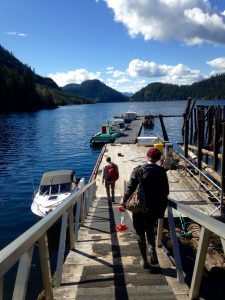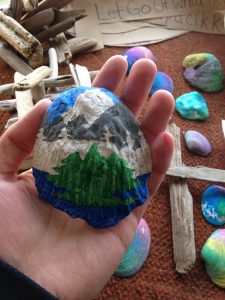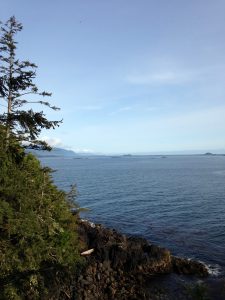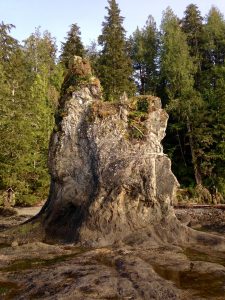My community contact partner – the school principal – picked me up from Campbell River at 7:45am on Monday. Our first stop was in the same city, where we picked up a mother from the village who was also headed for Kyuquot. “Because our community is so small” the school principal explained, “it is important that we help each other out. It also helps the reputation of the school that we actively engage with the community of Kyuquot itself, so I often find myself helping others get to where they need to go.” Kyuquot is a First Nations village belonging to the Kyuquot and Cheklesahht peoples, who are part of the Nuu Chah Nulth nations of the Northwest Pacific. To get the village, travellers must reach Vancouver Island either through Nanaimo or Victoria. From there, they must drive for hours to reach Campbell River, before taking the highway to Woss. For the final stretch of the journey to Kyuquot, travellers brave four hours of driving down busy logging roads from Woss, to Zeballos, and finally to Fair Harbour, where they must then arrange for a private water taxi to ferry them to Kyuquot. Alternatively, travellers can take a shipping vessel that travels from Gold River to Kyuquot once a week – about a four hour ride on the Uchuck. The point to be made is that Kyuquot is remote and not easily accessed.
at 7:45am on Monday. Our first stop was in the same city, where we picked up a mother from the village who was also headed for Kyuquot. “Because our community is so small” the school principal explained, “it is important that we help each other out. It also helps the reputation of the school that we actively engage with the community of Kyuquot itself, so I often find myself helping others get to where they need to go.” Kyuquot is a First Nations village belonging to the Kyuquot and Cheklesahht peoples, who are part of the Nuu Chah Nulth nations of the Northwest Pacific. To get the village, travellers must reach Vancouver Island either through Nanaimo or Victoria. From there, they must drive for hours to reach Campbell River, before taking the highway to Woss. For the final stretch of the journey to Kyuquot, travellers brave four hours of driving down busy logging roads from Woss, to Zeballos, and finally to Fair Harbour, where they must then arrange for a private water taxi to ferry them to Kyuquot. Alternatively, travellers can take a shipping vessel that travels from Gold River to Kyuquot once a week – about a four hour ride on the Uchuck. The point to be made is that Kyuquot is remote and not easily accessed.

On the drive to Fair Harbour, my principal asked me what I knew about about rural education, outdoor education, and alternative education. “Not much on all three,” was my reply, “but I am always eager to learn and the purpose of my CFE is to enrich my educational experience as a teacher candidate by experiencing education in an unfamiliar context.” He went on to say that the educational environment at my CFE school, Kyuquot Elementary Secondary School (K.E.S.S.), is more akin to that of an alternative education setting than any conventional classroom – this due to the diverse learning needs of each student. This quickly led to a discussion on who we saw ourselves as professionals. He told me that his view was that “teacher” is an oppressive word, because it implies that our only job is to “teach” to our students and share no further responsibilities. “I prefer to call people like us ‘learning professionals’, because it is our job to discern what each learner requires in order to be successful”. After hearing this, I sat quietly to reflect and look at the beautiful northern Vancouver Island scenery passing by. After some thought, I told him that I agreed – that a shift in thinking was necessary. I speak German and drew on that background knowledge to understand the lesson he was sharing with me. In German the verb “to learn” and the word “teacher” have the same root (“lernen” and “Lehrer” respectively), whereas in English, we have “learning” and “teacher”. I realized that this was the first of many important lessons during my CFE. I am a learning professional.
The next day, I met the amazing staff of K.E.S.S. and began working with the students, who possess a wide range of ability in their learning. The school is very small at 50 students spanning grades K-12, which makes planning and instruction a challenge for the teachers at the school. The school’s approach to giving students 21st century skills is therefore very unique to this context. The students respond more positively to one-on-one interactions, as opposed to collaborative work. To many of them, a new face in a community as small as Kyuquot is a big change and I am confident that, after seeing me around the school for a time, they will warm up to my presence. For now, I will be spending my remaining two weeks at the school continuing to build strong personal relationships with the students. Another of my responsibilities during the CFE is to assist the staff at the continuing education centre in the village. My specific role is to be present as a support to graduation candidates. So far it has been challenging ensuring that students are motivated enough to show up Tuesdays and Thursdays after school.

In Kyuquot, teachers live in the hills behind the school in teacherages, which are comfortable and have incredible views of the school and bay. The staff at K.E.S.S. have been very warm and welcoming, allowing me to enter their classrooms and assist them however I can. I made sure I spent time in each of the classrooms to observe different teaching styles and for the students themselves to observe me in different areas of the school. My CFE contact told me that, in order to make the most of my CFE experience, I would have to take responsibility for my own learning. This led me to a remarkable moment – if I am to expect my students to take responsibility for their learning, then I am responsible for not only practicing what I preach, but modelling that behaviour in a clear way for my students.
On Wednesday, the principal took me on a hike behind the school overlooking the Clanninick valley. It was a relatively short (2 hour) hike, but strenuous as we were hiking up a mountain side. When we reached the end of the path, he told me to find an isolated area of the forest for reflection and meditation. I found a beautiful old cedar and decided that this place was as good as any. During my reflection, I made sure to establish a connection to the local environment by using my senses to ground myself in Kyuquot. It may sound strange, but I knew that a successful CFE experience meant understanding the connection to learning and environment. While I was reflecting, I began thinking of a single word I might use to describe the forest… was it ancient? protecting? sustaining? passive? eternal? sacred? Coming from a humanities background, language was my natural point of contact. I still have not decided on a word, but on the hike back to our teacherage, I was beginning to wonder whether a single word was necessary or appropriate.
 On Friday, the students spent the day crafting gifts for the potlatch to be held at Bella Bella next week. I painted a shell, while others made driftwood mobiles, necklaces, bracelets, tie-dyed shells, and even cedar baskets. After school, all of the teachers went together to Walter’s Cove to go drop off our garbage at the bins situated there and go for a hike. We spent all afternoon being in each other’s company in the forest and I must say it felt rejuvenating. To wrap up the day and indeed the week, one of the students took us teachers to the tip of Walter’s Cove to see Thlaathluktiinlth (“Two Hundred Mouths”). According to Nuu Chah Nulth Kyuquot/Checleseht oral tradition, Thlaathluktiinlth is the being responsible for the creation of their traditional territories and their chiefly families. Writing at the end of my first week at Kyuquot, I truly feel more closely connected to this place where learning happens. One point of interest I intend to explore in my remaining two weeks is exploring how learning – in its entirety – happens in this isolated, serene corner of our world.
On Friday, the students spent the day crafting gifts for the potlatch to be held at Bella Bella next week. I painted a shell, while others made driftwood mobiles, necklaces, bracelets, tie-dyed shells, and even cedar baskets. After school, all of the teachers went together to Walter’s Cove to go drop off our garbage at the bins situated there and go for a hike. We spent all afternoon being in each other’s company in the forest and I must say it felt rejuvenating. To wrap up the day and indeed the week, one of the students took us teachers to the tip of Walter’s Cove to see Thlaathluktiinlth (“Two Hundred Mouths”). According to Nuu Chah Nulth Kyuquot/Checleseht oral tradition, Thlaathluktiinlth is the being responsible for the creation of their traditional territories and their chiefly families. Writing at the end of my first week at Kyuquot, I truly feel more closely connected to this place where learning happens. One point of interest I intend to explore in my remaining two weeks is exploring how learning – in its entirety – happens in this isolated, serene corner of our world.
Until next time,
Alex M.